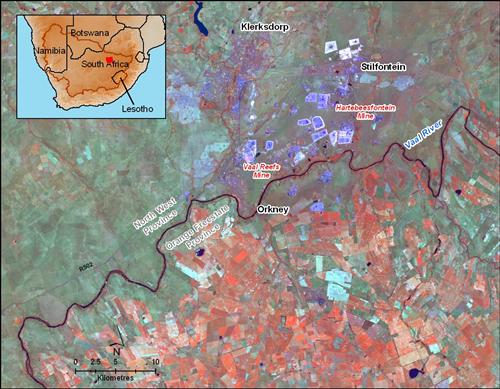Radio-nuclides can negatively impact biota through mutagenic and carcinogenic effects, given sufficient doses over a period of time. Uptake of radio-active particles may be direct, through ingestion, or indirect through the food chain. As there is no basin-wide radio-nuclide monitoring programme, the magnitude and significance of the problem is not known, especially its transboundary effects. The causes of radio-nuclide contamination in water can mainly be ascribed to a lack of adequate environmental management and control in the mines (particularly gold and uranium) and other industrial sites where radio-active materials may be produced or stored.

Gold mines along the Vaal River near Klerksdorp in the North West Province of South Africa.
Source:Hatfield 2009
( click to enlarge )
Gold Mines in the West Rand of South Africa, such as those around Carltonville, Klerksdorp and Welkom, have experienced high levels of radiation from Uranium-238, Thorium-230, Radium-226 and Radon-222 associated with Gold deposits (Government of North West Province 2002).
Box: Impacts of Radioactivity from Mining Activities
Impacts from radioactivity include: atmospheric impacts (radionuclide-contaminated dust); terrestrial environmental impacts (e.g., soil contamination, aquatic sediment contamination and bioaccumulation of radionuclides in ecosystems) and human health impacts (genetic mutations, radiation sickness and mental retardation at high levels). There is a growing body of evidence pointing that both the long- and short-term effects of radioactive substances present in the environment may be impacting on the health of the population of the Province, particularly in the gold mining areas.
Source: Government of North West Province 2002.
